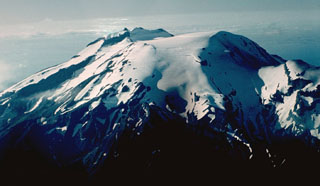Report on Calbuco (Chile) — 6 May-12 May 2015
Smithsonian Institution / US Geological Survey
Weekly Volcanic Activity Report, 6 May-12 May 2015
Managing Editor: Sally Sennert.
Please cite this report as:
Global Volcanism Program, 2015. Report on Calbuco (Chile) (Sennert, S, ed.). Weekly Volcanic Activity Report, 6 May-12 May 2015. Smithsonian Institution and US Geological Survey.
Calbuco
Chile
41.33°S, 72.618°W; summit elev. 1974 m
All times are local (unless otherwise noted)
OVDAS-SERNAGEOMIN reported that on 6 May activity at Calbuco fluctuated; a sudden increase of tremor that began at 1304 and lasted two hours was accompanied by increased gas-and-ash emissions. During 7-11 May the gas-and-ash emissions were steady and low (less than 1 km), and drifted E, SE, and S; inclement weather prevented observations during 8-10 and 12 May. Moderate levels of tremor were detected through 9 May, and then decreased to low levels through 12 May. According to ONEMI, the number of evacuees within the 20-km evacuation zone remained at 6,685 on 12 May. In addition 3,221 animals, including sheep, goats, cows, and horses, had been evacuated. The Alert Level remained at Red (the highest level on a four-color scale).
Satellite images showed that the aerosol plume from the initial few days of the eruption had traveled around the world once; faint layers of the plume were 14-16 km above parts of South America during 8-9 May.
Geological Summary. Calbuco is one of the most active volcanoes of the southern Chilean Andes, along with its neighbor, Osorno. The late-Pleistocene to Holocene andesitic volcano is immediately SE of Lake Llanquihué in the Chilean lake district. Guanahuca, Guenauca, Huanauca, and Huanaque, all listed as synonyms of Calbuco (Catalog of Active Volcanoes of the World), are actually synonyms of nearby Osorno volcano (Moreno 1985, pers. comm.). The edifice is elongated in a SW-NE direction and is capped by a 400-500 m wide summit crater. The complex evolution included collapse of an intermediate edifice during the late Pleistocene that produced a 3-km3 debris avalanche that reached the lake. It has erupted frequently during the Holocene, and one of the largest historical eruptions in southern Chile took place from Calbuco in 1893-1894 that concluded with lava dome emplacement. Subsequent eruptions have enlarged the lava-dome complex in the summit crater.
Sources: Servicio Nacional de Geología y Minería (SERNAGEOMIN), Oficina Nacional de Emergencia-Ministerio del Interior (ONEMI), Mike Fromm, US Naval Research Laboratory

